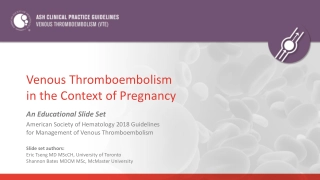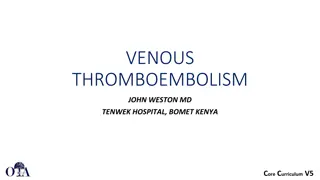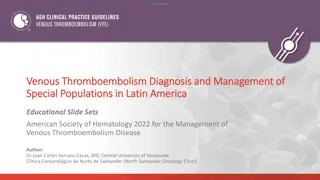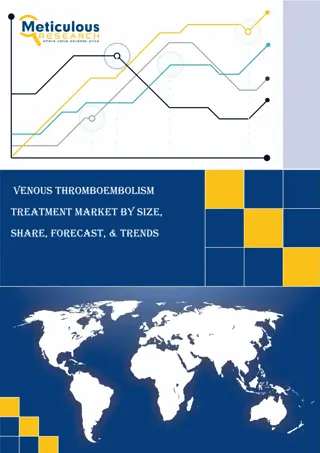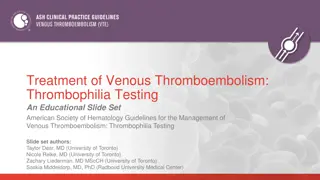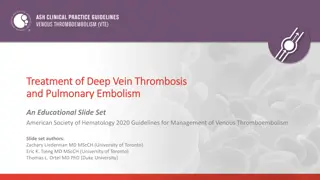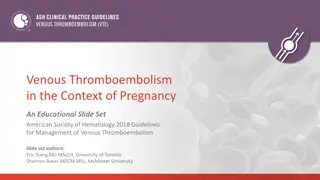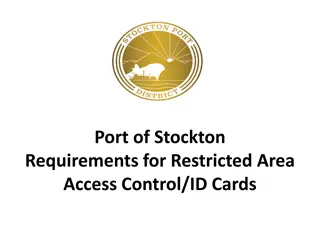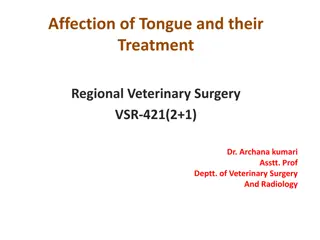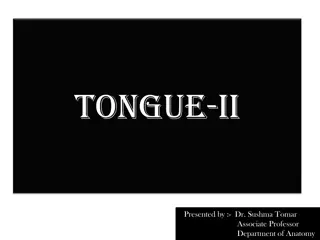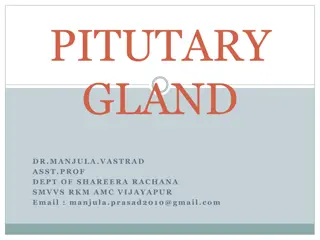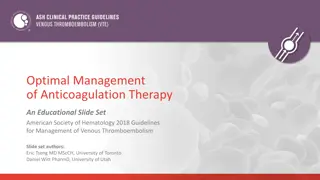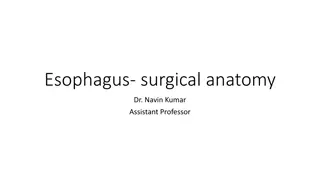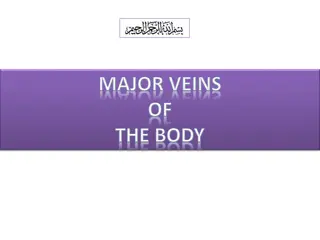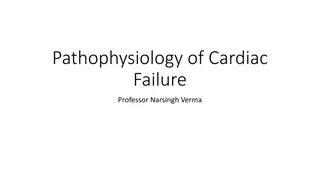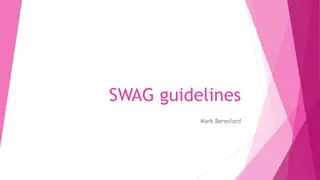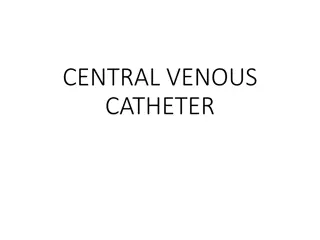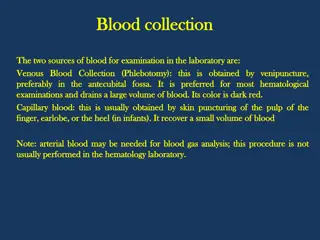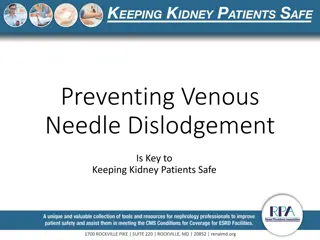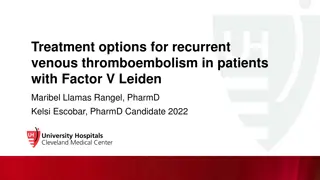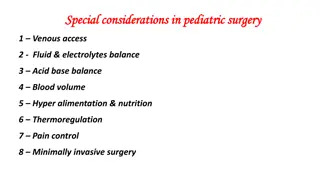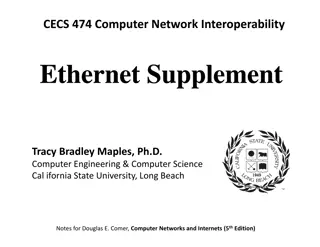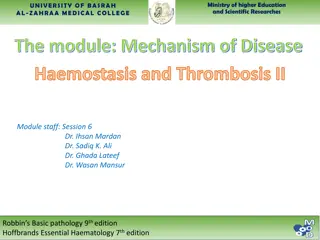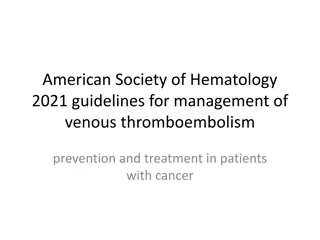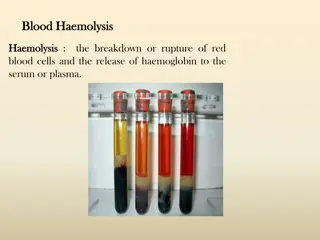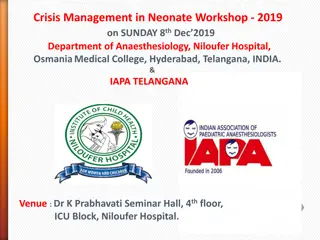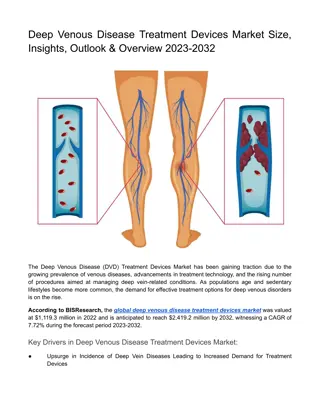Venous Thromboembolism in the Context of Pregnancy
Key guidelines from the American Society of Hematology (ASH) in 2018 focus on managing venous thromboembolism in pregnancy. The guidelines cover prevention, treatment, and optimal management of VTE in various clinical settings. Panels formed for guideline development included diverse expertise to en
1 views • 49 slides
Understanding Venous Thromboembolism in Orthopedic Patients
This educational content covers the basics of deep vein thrombosis (DVT) and pulmonary embolism (PE), including definitions, pathophysiology, risk factors, prevention strategies, diagnosis, and treatment. Traumatic and non-traumatic risk factors for VTE in orthopedic patients are discussed, emphasiz
0 views • 36 slides
Venous Thromboembolism Diagnosis and Management in Latin America: ASH 2022 Educational Slide Sets
The American Society of Hematology (ASH) 2022 guidelines for the diagnosis and management of venous thromboembolism in special populations in Latin America are presented in educational slide sets authored by Dr. Juan Carlos Serrano Casas and other experts. The Latin American ADOLOPMENT project, a co
0 views • 52 slides
Central Venous Catheter Access Management in Brampton and Surrounding Areas
Nurse-led Outreach Team in Brampton, North Etobicoke, West Woodbridge, Malton, and Bramalea provides education on managing central venous catheter access devices like PICCs. Learn about preventing infections, post-insertion care, types of CVADs, and aseptic techniques for PICC line management.
1 views • 20 slides
Understanding Coronary Artery Bypass Graft (CABG) in Adult Nursing
Coronary Artery Bypass Graft (CABG) is a surgical procedure where a blood vessel from another part of the body is grafted onto an occluded coronary artery to bypass blockages. This procedure is less common in women compared to men and is typically indicated for severe coronary artery disease. It is
5 views • 15 slides
Understanding Central Venous Line (CVL) and Central Venous Pressure (CVP) Monitoring
Central Venous Line (CVL) and Central Venous Pressure (CVP) monitoring play critical roles in intensive care settings. This article covers the indications, types, insertion sites, and contraindications of CVL. It also explains the significance of CVP measurement and how to perform and interpret it u
3 views • 40 slides
2022 Thales Access Management Index
Thales Access Management Index highlights the current landscape of access security, revealing insights on multi-factor authentication adoption, remote and privileged user access management, VPN usage trends, challenges faced, and preferences towards third-party access management. The report emphasiz
2 views • 9 slides
Venous Thromboembolism Market
Venous thromboembolism occurs when a blood clot forms in a vein, obstructing the blood flow and posing a potentially life-threatening risk. Several devices and drugs are employed for the prevention and treatment of venous thromboembolism. The devices considered within this scope are utilized for bot
5 views • 3 slides
Guidelines for Thrombophilia Testing in Venous Thromboembolism Management
The American Society of Hematology (ASH) provides comprehensive guidelines for the management of venous thromboembolism (VTE) with a focus on thrombophilia testing. Expert panels develop recommendations based on clinical questions, evidence synthesis, and resource use. These guidelines cover various
2 views • 47 slides
Personnel Safety Systems and Access Control at CERN Facilities
Personnel Safety Systems at CERN include ODH detection, fire safety measures, and access control to protect personnel from hazards. Various access control layers are implemented to regulate entry to different parts of the facility, ensuring only trained personnel access underground areas. Biometric
0 views • 19 slides
ASH Guidelines 2020: Management of Venous Thromboembolism
American Society of Hematology (ASH) released guidelines in 2020 for the management of Venous Thromboembolism, focusing on deep vein thrombosis and pulmonary embolism. These guidelines cover prevention, treatment, and optimal management strategies. The recommendations are developed through a rigorou
0 views • 45 slides
Understanding Cardiac Output and Venous Return in Cardiovascular Physiology
Cardiac output, stroke volume, end-diastolic and end-systolic volumes play vital roles in cardiovascular function. Factors affecting cardiac output include physiological conditions and pathological states like hyperthyroidism and myocardial infarction. Venous return, controlled by mechanisms like Fr
0 views • 27 slides
ASH Guidelines on Venous Thromboembolism in Pregnancy
The American Society of Hematology (ASH) 2018 guidelines provide comprehensive management recommendations for venous thromboembolism in pregnancy. Key aspects include panel formation, clinical questions generation, evidence synthesis, and making recommendations. The guidelines offer strong and condi
0 views • 49 slides
Port of Stockton Restricted Area Access Control and ID Card Policy
Access to restricted areas at the Port of Stockton facilities requires possession of a TWIC (Transportation Worker Identification Credential). Only authorized personnel, such as employees, contractors, and those with regular access, may receive a Port Access Card after approval by the Facility Secur
0 views • 6 slides
Treatment of Tongue Affections in Veterinary Surgery by Dr. Archana Kumari
In this educational material, Dr. Archana Kumari discusses various tongue affections in animals such as strangulation, smooth tongue, tumors, and ranula. Treatment methods for each condition are described in detail, providing valuable insights for veterinary surgeons. From managing venous engorgemen
0 views • 21 slides
Understanding the Intrinsic Muscles of the Tongue - Anatomy and Physiology Overview
In this detailed presentation by Dr. Sushma Tomar, Associate Professor of Anatomy, the intrinsic muscles of the tongue are explored, along with their functions, arterial and venous supply, lymphatic drainage, and nerve supply. The lecture covers the four intrinsic muscles in each half of the tongue,
1 views • 15 slides
Overview of Pituitary Gland: Structure, Function, and Relationships
The pituitary gland, also known as the hypophysis, is an endocrine gland located at the base of the brain. It is divided into two main parts: the adenohypophysis and the neurohypophysis. The gland plays a crucial role in hormone regulation and is closely related to neighboring structures such as the
0 views • 26 slides
Optimal Management of Anticoagulation Therapy - ASH 2018 Guidelines
The American Society of Hematology (ASH) 2018 guidelines focus on the optimal management of anticoagulation therapy, specifically in the context of venous thromboembolism (VTE). The guidelines cover topics such as prevention, treatment, and management strategies, developed through thorough panel for
0 views • 43 slides
Guidelines for Management of Pediatric Venous Thromboembolism
This educational slide set presents the American Society of Hematology's 2018 guidelines for the treatment of pediatric venous thromboembolism. The guidelines cover various aspects such as prevention, treatment, and optimal management of anticoagulation therapy in pediatric patients. Panels were for
0 views • 47 slides
Esophagus Surgical Anatomy Overview
This detailed overview of esophagus surgical anatomy covers the anatomical structure and relationships, constrictions, clinical importance, length, blood supply, venous drainage, and nerve supply. The content includes informative images and descriptions provided by Dr. Navin Kumar, Assistant Profess
0 views • 49 slides
Overview of Veins and Venous Circulation in the Body
Veins play a crucial role in the circulatory system by carrying deoxygenated blood back to the heart. This lecture covers the general principles of veins, the anatomy of major veins like the superior and inferior vena cavae, tributaries, and their roles in different parts of the body. It also discus
0 views • 14 slides
Optimal Management of Anticoagulation Therapy: ASH 2018 Guidelines
Educational slide sets and clinical guidelines by the American Society of Hematology (ASH) provide recommendations for the management of venous thromboembolism, including the optimal use of anticoagulation therapy. The guidelines detail panel formation criteria, development process, evidence synthes
0 views • 43 slides
Pathophysiology of Cardiac Failure and Adaptive Mechanisms of the Heart
Cardiac failure is a condition where the heart is unable to meet tissue metabolic needs despite normal or increased venous return. Causes include decreased contractility, coronary blood flow, damaged valves, and more. Normal resting cardiac output is 5 Lt/mts, with adaptive mechanisms like the Frank
0 views • 35 slides
Extended Endocrine Therapy Guidelines for Breast Cancer Patients
Extended adjuvant endocrine therapy may benefit breast cancer patients with poor or intermediate prognosis, but may have little value for those with good prognosis. Risks include osteoporosis and venous thromboembolism. Different treatment options are available for postmenopausal and premenopausal w
0 views • 9 slides
Central Venous Catheters: Uses, Placement, and Indications
A central venous catheter (CVC) is a crucial medical device placed into a large vein for various purposes like administering medication, fluids, and obtaining blood tests. The catheter can be tunneled or non-tunneled, and specific sites are preferred for each type. Indications for CVC usage include
1 views • 19 slides
Pediatric Vascular Access Techniques and Considerations
This article discusses various vascular access methods in infants and children, including peripheral IV access, central venous access, arterial lines, and ultrasound-guided techniques. It covers indications, sites, complications, and techniques for each method, emphasizing the importance of proper a
1 views • 56 slides
Advances in Anticoagulation Therapy for Cancer-Related VTE and Stroke
Recent studies have shown advancements in anticoagulation therapy for cancer patients with venous thromboembolism (VTE) and stroke prevention. Direct oral anticoagulants (DOACs) are now considered beneficial for treating VTE in cancer, offering advantages in administration and efficacy. Different an
3 views • 9 slides
Venous Blood Collection Methods and Equipment Overview
Venous blood collection techniques, including antecubital fossa and heel sticks, are commonly used for laboratory examinations. Venous blood is preferred for its large volume and ease of recovery. This article also explores the differences between capillary and venous blood samples in terms of compo
0 views • 8 slides
Understanding Venous Needle Dislodgement in Dialysis Patients
Venous Needle Dislodgement (VND) is a serious complication of hemodialysis that can lead to significant blood loss and even mortality. It occurs when the venous fistula needle becomes dislocated, resulting in blood loss ranging from minor to fatal. The risk factors, consequences, and frequency of VN
0 views • 30 slides
Treatment Strategies for Recurrent Venous Thromboembolism in Factor V Leiden Patients
This presentation discusses the treatment options for recurrent venous thromboembolism in patients with Factor V Leiden mutation. It explores the pathophysiology, epidemiology, and diagnosis criteria for Factor V Leiden, reviews failed anticoagulation history, and suggests outpatient anticoagulation
0 views • 31 slides
Pediatric Surgery: Special Considerations for Venous Access and Fluid Management
Pediatric surgery requires special attention to venous access and fluid management due to unique considerations in infants and children. Key aspects include methods for obtaining vascular access, monitoring fluid and electrolyte balance, and addressing specific fluid requirements based on age and we
0 views • 15 slides
Open Access at Charles University: Opportunities and Challenges
Charles University is navigating the landscape of open access following the implementation of the Czech National Open Access Strategy. The university is working towards making all research articles and proceeding papers open access, monitoring article processing charges, and promoting open access as
0 views • 24 slides
Understanding Ethernet and Multiple Access Protocols in Computer Networks
Exploring the fundamentals of Ethernet and multiple access protocols in computer networks, this content discusses the two primary categories of multiple access protocols - contention access and controlled access. It delves into topics such as CSMA/CD, LANs, performance of multiple access schemes, ad
0 views • 7 slides
Understanding Embolism and Venous Thrombosis in Mechanism of Disease
Embolism, defined as a detached intravascular mass carried through the blood, poses serious risks like pulmonary embolism. Venous thrombosis, particularly deep vein thrombosis (DVT), can lead to embolization, emphasizing the importance of understanding these mechanisms in medical practice.
0 views • 40 slides
Harvard Chan School 2021 Yearly Access Review Process
The Harvard Chan School conducts its annual Yearly Access Review (YAR) process to review user access to various financial systems. The process involves assessing permissions, levels of access, and organizational details for each team member. Instructions are provided on reviewing worksheets, adding
0 views • 19 slides
Understanding Security Access in PeopleSoft Finance
Explore the various levels of security access in PeopleSoft Finance, from basic entry access to transaction entry, approvals, and procurement processes. Learn how to request individual and department security access and find relevant forms on the financial services website. Discover the different ty
0 views • 11 slides
American Society of Hematology 2021 Guidelines for Venous Thromboembolism in Cancer Patients
The American Society of Hematology (ASH) 2021 guidelines provide recommendations for preventing and treating venous thromboembolism (VTE) in cancer patients. The guidelines cover primary prophylaxis for hospitalized medical patients and those undergoing surgery, emphasizing the use of thromboprophyl
0 views • 23 slides
Understanding Blood Haemolysis and Specimen Rejection in Laboratory Testing
Blood haemolysis refers to the release of haemoglobin from red blood cells, affecting test results. Specimen rejection occurs due to various factors like unsuitable conditions, safety hazards, and improper labeling. Capillary puncture technique is used for patients with difficult venous access. Guid
0 views • 8 slides
Crisis Management in Neonate Workshop 2019 at Niloufer Hospital, Hyderabad
A workshop on Crisis Management in Neonate is scheduled to be held on December 8th, 2019, at Niloufer Hospital, Osmania Medical College, Hyderabad, India. The event aims to enhance knowledge and skills in neonatal venous access, intubation techniques, airway management, and cardiovascular challenges
0 views • 5 slides
Deep Venous Disease Treatment Devices Market
The global deep venous disease treatment devices market was valued at $1,119.3 million in 2022 and is anticipated to reach $2,419.2 million by 2032, witnessing a CAGR of 7.72% during the forecast period 2023-2032.\n\nRead Report Overview: \/\/bisrese
1 views • 3 slides
